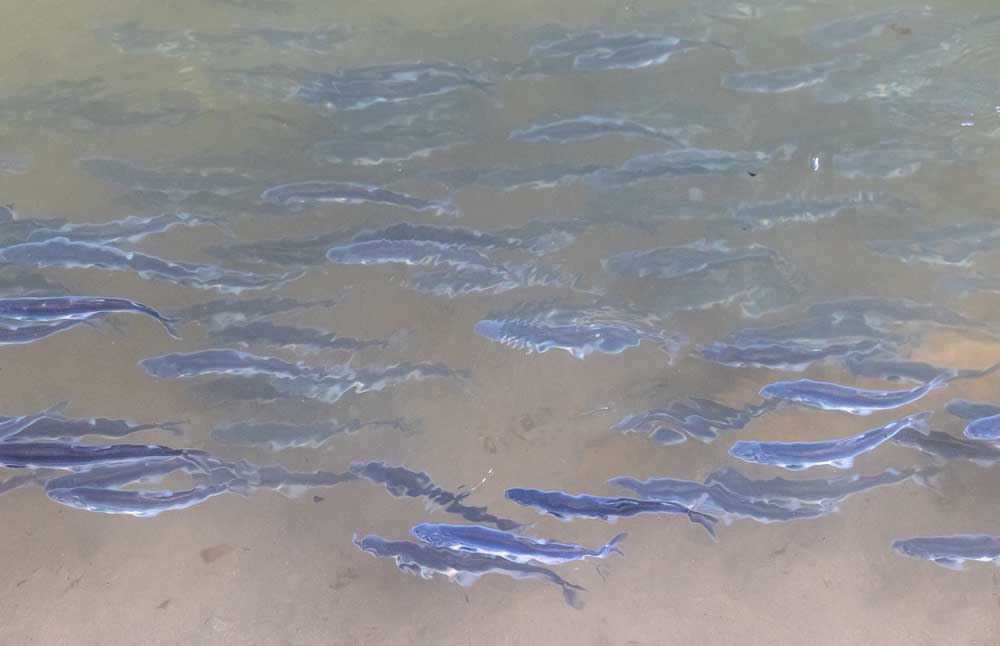Sandy River smelt fishery draws hundreds for rare harvest opportunity at Troutdale
Published 4:30 pm Thursday, March 27, 2025

- Smelt swim in the Sandy River Thursday during a one-day permitted harvest of the fish, which hundreds of dipnetters turned out for.
They came with small nets and large nets. Nets of gray, white, and pink. They came in chest waders, sneakers, and with buckets in hand. Men, women, boys, girls, families, and friends.
Trending
This was the scene Thursday afternoon and evening, March 27 as hundreds, if not thousands, of people from near and far converged on the lower Sandy River for the rare, one-day opportunity to harvest eulachon smelt, a small migratory fish at the center of a rich tradition stretching back centuries.
The Oregon Department of Fish and Wildlife (ODFW) opened the seven-hour fishery after determining that enough smelt were returning to the river on the final leg of their migratory journey.
Among those trying their luck was Katelyn Driver of Grayland, a small community on the Pacific Coast of Washington. She and her father, Dave, chuckled as they pointed out that they drove more than three hours to spend just 10 minutes hauling in their 10-pound limits of smelt from the Sandy River.
Trending
“This is awesome,” Katelyn said. “We haven’t gotten them this quickly ever,” she added, referencing previous smelt-dipping trips to the Cowlitz River in Southwest Washington.
“I feel like a kid in a candy store,” Katelyn said.
In a fun twist, Dave is a retired commercial fisherman, and Katelyn was his deckhand.
Others who arrived in Troutdale for the event included Andre Gonzales of Estacada, who consented to have his photo taken, and Alex Gentry of Clackamas, who was accompanied by her son, Ladd, seemingly unfazed by the river’s frigid waters.
“I came out two years ago for the smelt season,” Alex said. “It’s a lot easier this year,” she added, as her drenched son lifted another net full of smelt.
“This is such a Pacific Northwest activity,” Alex said. “I don’t know anywhere else you can get that many fish at once.”
She applauded ODFW for timing the fishery with spring break, allowing her to introduce her children to this family tradition.
But ODFW can’t take credit for the timing.
Ben Walczak, district fish biologist for ODFW’s North Willamette District, said the smelt’s return to the Sandy River during spring break is a happy coincidence.
Walczak described the smelt as a bit of a mystery, saying there isn’t a clear explanation for why the fish don’t return every year. Smelt are migratory, hatching in the Sandy River, then following the Columbia River to the Pacific Ocean, where they spend most of their lives. Biologists track smelt returns by observing the behavior of prey birds and other aquatic mammals.
What is it about the Sandy River that smelt like? It’s probably a combination of the right water temperature, stream flow, and sandy riverbed. Walczak said the smelt don’t venture far up the river, typically stopping at Dabney State Park before completing their spawning run. The run lasts only a couple of days.
Smelt fishing was a popular annual pastime on the Sandy River through the 1970s when hundreds of people could be seen lining the riverbanks armed with dipnets. But the smelt population dwindled, leading to the end of the dipnet tradition.
Though eulachon smelt were listed as threatened under the Endangered Species Act in 2010, their population has rebounded enough to allow for a controlled, limited harvest.
The last such fishery was a one-day event in 2023, following similar opportunities in 2015, 2014, 2003, and 2002.
A Native Tradition
Smelt, also known as “oolichan” in some Indigenous languages, were part of the diet for Indigenous peoples of the Pacific Northwest for centuries. The fish was prized not only as a food source but also for its high oil content, which had both cultural and economic significance.
Indigenous peoples caught the fish using nets, traps, or spear fishing. The fish was often smoked, dried, or processed into oil, which could be stored for the rest of the year.







